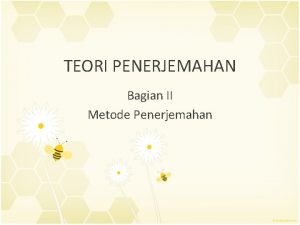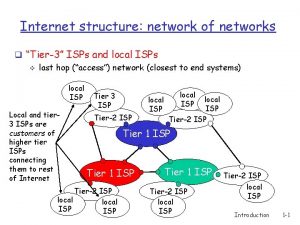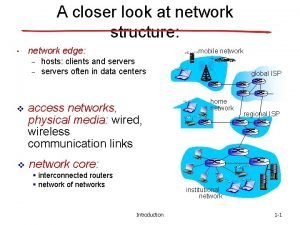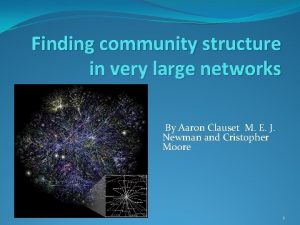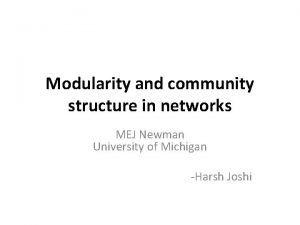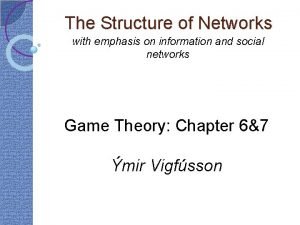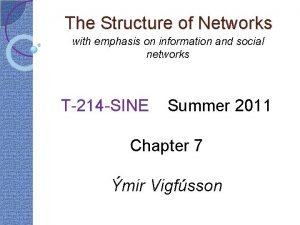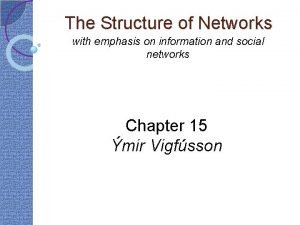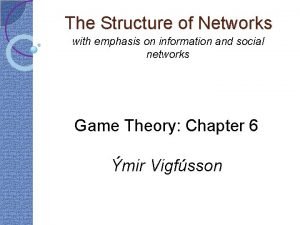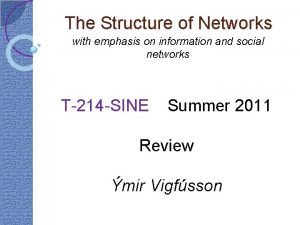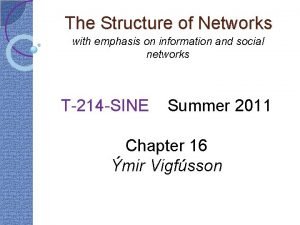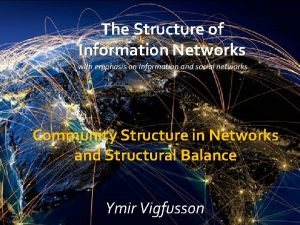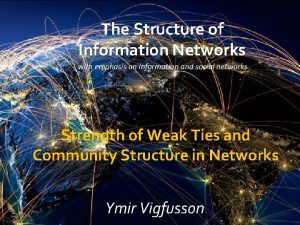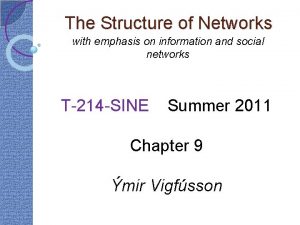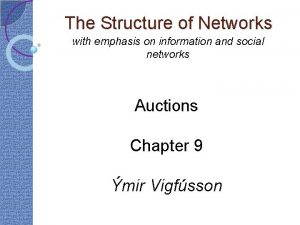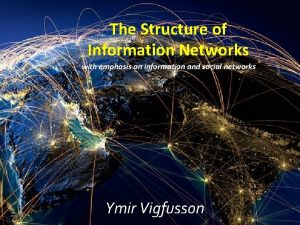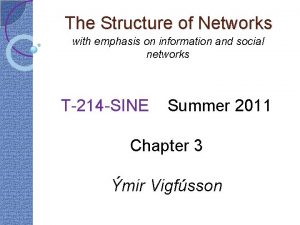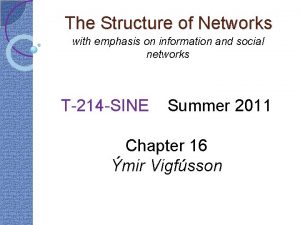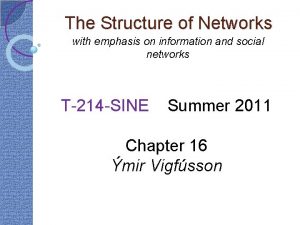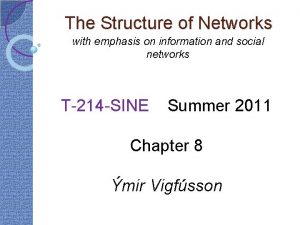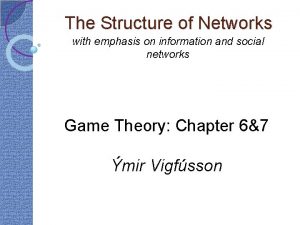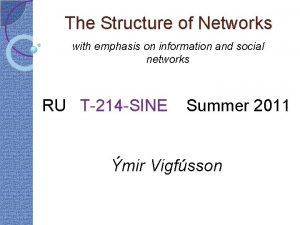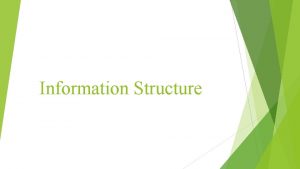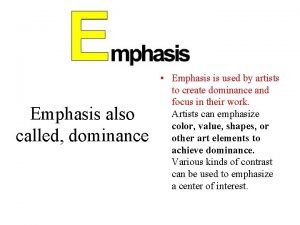The Structure of Networks with emphasis on information





































- Slides: 37

The Structure of Networks with emphasis on information and social networks T-214 -SINE Summer 2011 Chapter 2 Ýmir Vigfússon

Graph theory �We will develop some basics of graph theory ◦ This provides a unifying language for network structure �We begin with central definitions ◦ Then consider the implications and applications of these concepts

Graph theory �A graph or a network is a way to specify relationships amongst a collection of items �Def: A graph consists of ◦ Set of objects: nodes ◦ Pairs of objects: edges �Def: Two nodes are neighbors if they are connected by an edge

Graph orientation �Both graphs have 4 nodes (A, B, C, D) and 4 edges �The left graph is undirected ◦ Edges have no orientation (default assumption) �The right graph is directed ◦ Edges have an orientation, e. g. edge from B to C

Weighted graphs �Edges may also carry additional information ◦ Signs (are we friends or enemies? ) ◦ Tie strength (how good are we as friends? ) ◦ Distance (how long is this road? ) ◦ Delay (how long does the transmission take? ) �Def: In a weighted graph, every edge has an associated number called a weight. �Def: In a signed graph, every edge

Graph representations �Abstract graph theory is interesting in itself �But in network science, items typically represent real-world entities ◦ Some network abstractions are very commonly used �Several examples (more later) ◦ Communication networks �Companies, telephone wires ◦ Social networks �People, friendship/contacts ◦ Information networks �Web sites, hyperlinks ◦ Biological networks �Species, predation (food web). Or metabolic pathways

ARPANET: Early Internet precursor �December 1970 with 13 nodes

Graph representation �Only the connectivity matters ◦ Could capture distance as weights if needed

Transportation networks �Graph terminology often derived from transportation metaphors ◦ E. g. “shortest path“, “flow“, “diameter“

A structural network �The physics of rigidity theory is applied at every network node to design stable structures

An electrical network �The physics of Kirchoff‘s laws is applied at every network node and closed paths to design circuits

Graph concepts �“Graph theory is a terminological jungle in which every newcomer may plant a tree“ (Social scientist John Barnes) �We will focus on the most central concepts ◦ ◦ ◦ Paths between nodes Cycles Connectivity Components (and giant component) Distance (and search)

Paths �Things often travel along the edges of a graph ◦ Travel ◦ Information ◦ Physical quantities �Def: A path is sequence of nodes with the property that each consecutive pair in the sequence is connected by an edge ◦ Can also be defined as a sequence of edges

Paths �MIT – BBN – RAND – UCLA is a path

Paths �You could also traverse the same node multiple times ◦ SRI – STAN – UCLA – SRI – UTAH – MIT �This is called a non-simple path �Paths in which nodes are not repeated are called simple paths

Cycles �These are ring structures that begin and end in the same node ◦ LINC – CASE – CARN – HARV – BBN – MIT – LINC is a cycle �Def: A cycle is a closed path with at least three edges �In the 1970 ARPANET, every edge is on a cycle ◦ By design. Why?

Connectivity �Can every node in a graph be reached from any other node through a path? ◦ If so, the graph is connected �The 1970 ARPANET graph is connected �In many cases, graphs may be disconnected ◦ Social networks ◦ Collaboration networks ◦ etc.

Connectivity �Is this graph connected? �What about now? ◦ A, B not connected to other nodes ◦ C, D, E not connected to other nodes

Components �If a graph is not connected, it tends to break into pieces that themselves are connected �Def: The connected components of an undirected graph are groups of nodes with the property that the groups are connected, and no two groups overlap �More precisely: ◦ A connected component is a subset of nodes such that (1) every node has a path to every other node in the subset, and (2) the subset is not a part of a larger set with the property that every node can reach another

Components �Three connected components ◦ {A, B}, {C, D, E}, {F, G, . . . , M}

Components: Analysis �A first global way to look at graph structure ◦ For instance, we can understand what is holding a component together �Real-world biology collaboration graph

Components: Analysis �Analyzing graphs in terms of densely connected regions and the boundaries of regions ◦ For instance, only include edges with weights above a threshold, then gradually increase threshold ◦ The graph will fragment into more and more components �We will later see how this becomes an important type of analysis

Giant components �Many graphs are not connected, but may include a very large connected components ◦ E. g. the financial graph from last lecture, or the hyperlink graph of the web �Large complex networks often contain a giant component ◦ A component that holds a large percentage of all nodes �Rare that two or more of these will exist in a graph. Why?

Romantic liasons in a high school Giant component �Existence of giant component means higher risk of STDs (the object of study)

Distance �Def: The distance between a pair of nodes is the edge length of the shortest path between them ◦ Just number of edges. Can be thought of as all edges having weight of 1 �What‘s SDC? the distance between MIT and

Distance �Q: Given a graph, how do we find distances between a given node and all other nodes systematically? ◦ Need to define an algorithm! �How would you approach this problem?

Distance: Breadth-first search (BFS) �From the given node (root) ◦ Find all nodes that are directly connected �These are labeled as “distance 1“ ◦ Find all nodes that are directly connected to nodes at distance 1 �If these nodes are not at distance 1, we label them as “distance 2“ ◦. . . ◦ Find all nodes that are directly connected to nodes at distance j �If these nodes are not already of distance at most j+1, we label them as „distance j+1“

Distance: Breadth-first search (BFS)

Distance: Breadth-first search (BFS)

Six degrees of separation �Explained thoroughly in the video we saw �First experiment done by Stanley Milgram in 1960 s (research budget $680) ◦ 296 randomly chosen starters. Asked to send a letter to a target, by forwarding to someone they know personally and so on. Number of steps counted. �Hypothesis: The number of steps to connect to anyone in a typical large-

Six degrees of separation �Milgram found a median hop number of 6 for successful chains – six degrees of separation ◦ This study has since been largely

Six degrees of separation �Modern experiment by Leskovec and Horvitz in 2008 �Look at the 240 million user accounts of Microsoft Instant Messenger �Complete snapshop (MS employees) �Found a giant component with very small distances �A random sample of 1000 users were tested ◦ Why do they look only at a sample?

Six degrees of separation �Estimated average distance of 6. 6, median of 7

Six degrees of geekiness �Co-authorship Erdös graph centered on Paul

Network data sets �Chapter 2 includes an overview of some massive data sets and networks �Collaboration graphs ◦ Wikipedia, World of Warcraft, Citation graphs �Who-talks-to-whom graphs ◦ Microsoft IM, Cell phone graphs �Information ◦ Hyperlinks linkage �Technological networks ◦ Power grids, communication links, Internet �Natural and biological networks ◦ Food webs, neural interconnections, cell metabolism

Network data sets �Leskovec‘s SNAP at Stanford has a repository of large-scale networks ◦ http: //snap. stanford. edu/data �I also have a few more data sets that could be appropriate for the group project �Keep thinking about whethere are some cool data sets that you might have access to. . .

Recap �A graph consists of nodes and edges �Graphs can be directed or undirected, weighted, signed or unweighted ◦ Paths between nodes (simple vs. nonsimple) ◦ Cycles ◦ Connectivity ◦ Components (and the giant component) ◦ Distance (and BFS) �Six degrees of separation can be checked with BFS
 Contoh penerjemahan semantik
Contoh penerjemahan semantik A switched wan is normally implemented as a
A switched wan is normally implemented as a Backbone networks in computer networks
Backbone networks in computer networks Tier 3 isps
Tier 3 isps Internet structure network of networks
Internet structure network of networks Finding community structure in very large networks
Finding community structure in very large networks Modularity and community structure in networks
Modularity and community structure in networks Hát kết hợp bộ gõ cơ thể
Hát kết hợp bộ gõ cơ thể Bổ thể
Bổ thể Tỉ lệ cơ thể trẻ em
Tỉ lệ cơ thể trẻ em Voi kéo gỗ như thế nào
Voi kéo gỗ như thế nào Chụp tư thế worms-breton
Chụp tư thế worms-breton Hát lên người ơi alleluia
Hát lên người ơi alleluia Môn thể thao bắt đầu bằng từ chạy
Môn thể thao bắt đầu bằng từ chạy Thế nào là hệ số cao nhất
Thế nào là hệ số cao nhất Các châu lục và đại dương trên thế giới
Các châu lục và đại dương trên thế giới Công của trọng lực
Công của trọng lực Trời xanh đây là của chúng ta thể thơ
Trời xanh đây là của chúng ta thể thơ Mật thư tọa độ 5x5
Mật thư tọa độ 5x5 Làm thế nào để 102-1=99
Làm thế nào để 102-1=99 Phản ứng thế ankan
Phản ứng thế ankan Các châu lục và đại dương trên thế giới
Các châu lục và đại dương trên thế giới Thơ thất ngôn tứ tuyệt đường luật
Thơ thất ngôn tứ tuyệt đường luật Quá trình desamine hóa có thể tạo ra
Quá trình desamine hóa có thể tạo ra Một số thể thơ truyền thống
Một số thể thơ truyền thống Cái miệng nó xinh thế
Cái miệng nó xinh thế Vẽ hình chiếu vuông góc của vật thể sau
Vẽ hình chiếu vuông góc của vật thể sau Biện pháp chống mỏi cơ
Biện pháp chống mỏi cơ đặc điểm cơ thể của người tối cổ
đặc điểm cơ thể của người tối cổ Thế nào là giọng cùng tên?
Thế nào là giọng cùng tên? Vẽ hình chiếu đứng bằng cạnh của vật thể
Vẽ hình chiếu đứng bằng cạnh của vật thể Vẽ hình chiếu vuông góc của vật thể sau
Vẽ hình chiếu vuông góc của vật thể sau Thẻ vin
Thẻ vin đại từ thay thế
đại từ thay thế điện thế nghỉ
điện thế nghỉ Tư thế ngồi viết
Tư thế ngồi viết Diễn thế sinh thái là
Diễn thế sinh thái là
